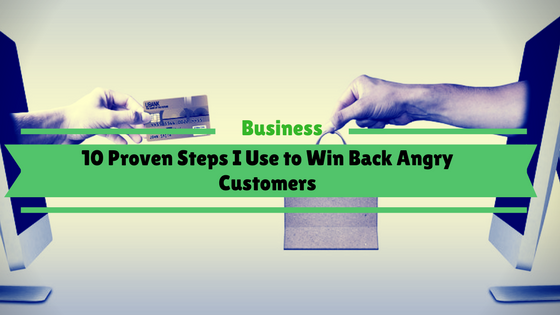⤴️-Paid Ad- Check advertising disclaimer here. Add your banner here.🔥
Search the Community
Showing results for tags 'business'.
-
At Blockchain Firm, we deliver the best real estate tokenization services for property owners and agencies to convert real estate properties into tokenized assets.
-
- business
- real estate
-
(and 2 more)
Tagged with:
-
Want to win back your angry customers ASAP like Akim my friend or stand akimbo and watch disappointed customers disappear with your money in their pockets? Meet Akim: Source: Whatsapp The above scenario mirrors the experience of many business owners, particularly those in competitive niches. They understand the value of a good customer and even the occasionally good customer, they know customer retention is 5x cheaper than customer acquisition. According to a Walker Study, 86 percent of buyers will pay more for a better customer experience. The report also states that by 2020 customer experience will overtake price and product as the key brand differentiator. Customer experience CX, is the customer’s perception of how your business treats them. The bad news, perception is subjective; sometimes no matter how you try some customers perception will always get in the way. To them customer delight is the amount of stress they are able to cause your Customer Service Reps. If you own or run a dropshipping ecommerce business, this becomes even more challenging because you do not see what your suppliers deliver to your customers on your behalf. This can lead to unpleasant experiences if customers get less than what they expect. Why Customers Get Upset Additionally, many online shoppers have good reason(s) to feel upset with your dropshipped products. Causes may include: Delayed deliveries Poor packaging Damaged goods Delayed returns/refunds Overbilling Poor service Having to repeat complaints severally to different customer care reps Failure to promptly address a wrong, and many more 4 Reasons Why It Should Bother You You should be concerned. Lead nurturing takes time and effort; hence customer retention should be top priority. Consumer behaviour patterns indicate that customers are becoming pickier and choosier, thanks to: 1. The Internet In 2016 there were over 3billion internet users worldwide, global internet access stood at 45 percent. What this means? Your target market can now access way more options straight from their phone inbox, social media feeds, bulk SMS etc. 2. Competitors Improved internet access increases competition. Suddenly you’re competing with brands from other lands, most of which are online offering products or services similar to yours. Your competitor is now just one click away. 3. Social Media People are now more connected than ever, Facebook has over 2 billion monthly active users. Part of what they discuss; their terrible customer experiences. Helpscout reports that there are over one million customer service related tweets daily, 80 percent of them negative. 4. Word of Mouth Nothing spreads word of mouth like social media. Your screw up can go viral in minutes, get thousands of shares and appear as feeds in millions of social media accounts. You don’t want that. The New Customer Persona: Customer 2.0 These days the customer is no longer just John, it includes those many others over whom John has significant influence, those who can either buy or fly based on John’s recommendation. And now John is upset with Akim! 10 Proven Steps to Win Back Angry Customers When clients or customers are upset, aim to not only resolve, overcompensate in a way that they smile and reward you with repeat and incremental business. I have implemented these steps severally in my independent ecommerce consultancy business with Jumia and have recorded nearly 100% success rate. Here’s what I told Akim. 1. Admit Do not play John Terry. As seller hold forte for the manufacturer as much as you safely can, even if your ToS says otherwise. Why win the case and lose the briefcase? You’ve got to own the 4 P’s the product the praise the profit and the problem If the complaint was made online, quickly investigate, admit if at fault and address ASAP. After fixing, encourage client to drop a kind word on same medium where the complaint was laid. American Express Survey reports that Americans tell an average of 9 people about good experiences, and 16 people about poor experiences. 2. Apologize After admitting, I usually say stuff like “I’m really sorry about your experience, I’ve sold X units of Y in the last Z months without issues. Yours appears to be an exception†Where possible apologize with company branded SMS, email, real mail, a personal call or note from the CEO for smaller businesses will be awesome. It’ll make John feel special and hopefully prepare him for a comeback. 3. Listen Given the right conditions, angry clients will vent. Listen actively, show understanding and empathy, nod occasionally, maintain eye contact if in person, lean forward toward client, express all that go-on-I’m-listening gestures, and take notes. It all shows you care and genuinely want to be of help. Provide toll free numbers or offer to call clients back if you mainly receive complaints over the phone. Reduce average hold time and average handling time if you use automated call centers, so they don’t feel you’re wasting their time. 4. Explain Now that you’ve heard their complaints you need to explain or address it as much as you can. Give details why and how it happened if you have the information. Inform client of the processes involved in obtaining a redress mentioning approximate timelines involved. Never pass the buck, use “we†instead of “they†5. Retrieve/Rollback Retrieve the offending item ASAP in the case of a physical product or rollback service. The more they see the faulty product/service the angrier they are likely to get. 6. Promise Promise to do your best to ensure issue is quickly resolved. As much as possible offer realistic timelines to keep hopes alive and strive to beat them, under promise and over deliver. Failure to meet promised deadlines will worsen an already bad situation. 7. Praise Praise them for understanding. They probably worked 9 to 5, 20 days a month to save up, came a long way past a handful of competitors and did business with you before their bad experience. They reached out, complained and have agreed to wait 8 months till you fix it. That’s amazing. 8. Update Update clients regularly. It keeps you on your feet and angry clients on their seats. It also reassures client that you’re doing your best to lay the matter to rest. They’ll likely let you know they appreciate your efforts. 9. Compensate Make up for lost time or other utility derivable from the product or service. For service, you can offer a discount, free upgrade or both as compensation. Strive to deliver compensation within deadline, the earlier the better. If, however an extension is inevitable, client is likely to consent having seen your commitment to resolve issue. 10. Demonstrate For physical products, demonstrate that the replacement is working perfectly before your delivery agents leave. Machines can be funny and the joke will be on you if after a long wait you still deliver a brand new faulty device. Conclusion Finally, gift them a voucher or coupon, that way you’re saying come back next time and when they do you know you’ve won them back. Remember: Admit when at fault Apologize immediately Listen attentively Explain effectively Retrieve/Rollback- ASAP Promise economically Praise lavishly Update regularly Compensate adequately and Demonstrate accordingly… That’s what I told Akim and that's what I tell you now. How have you handled customer disappointment in the past? Author Bio: Amos Onwukwe is an AWAI trained B2B/B2C Copywriter and Digital Marketer featured in eCommerce Nation, eCommerce Insights, Understanding Ecommerce, Floship, Huffington Post among others. He is available here and on Twitter@amos_onwukwe
-
FinTech as a financial term has got  into the mainstream news and vocabulary in 2017, and it should come as no surprise. Short for ‘financial technology’, the way we as individuals and large multinational corporations manage our finances is set to change for the better due to the natural evolution of technology in the digital age. Whether you’re acquainted with FinTech right now or not, everyone should be making an effort to at least understand what it is and why it’s really going to matter over the next decade and beyond. It will change the way we interact with our banks and the companies we seek services from for the better. FinTech is a big deal which is why we’re going to cover what it is and why you should make some time for it in 2017. So, What Exactly is FinTech? FinTech does not have a set in stone definition that everyone uses but in layman’s terms, it’s the utilisation of new and existing technology to optimise how cash is used and managed at both a business and individual level. This isn’t something which has just recently crept up from the corporate giants in Silicon Valley, this is something we’re already taking part in via things like Bitcoin and Contactless Credit Cards. The reason FinTech is only recently beginning to stir up conversation in normal everyday discussion is because we’re currently riding the early wave towards the boom of financial technology. Economists and software gurus alike have been speculating on the almost limitless applications of this postmodern technology. One day, according to some of these speculations, we could see ourselves borrowing money for a mortgage from multiple different everyday individuals through Blockchain technology, something that will, and is already, making global banks more and more obsolete. Why is it that banks, and by extension you, should be wary of Blockchain financial technology? Because, at its extreme, Blockchain could remove the need for banks and regulation altogether. Blockchain Technology: The End for Banks? Traditionally, the adding and subtracting of finances between individuals and businesses had to go through an intermediary who would ensure that ledgers are updated quickly, accurately, and safely. This is the main function of the banks we all tend to use, however, Blockchain FinTech has constructed a way in which these ledgers are public (but not publically readable), updated instantly across all participating individuals, and are highly secure. This is exactly the technology that underpins Bitcoin as a cryptocurrency and already demonstrates an early success of a digital currency which has no governmental or financial body’s rules imposed upon it. If you want to make money trading cryptocurrencies, like Bitcoin check our guide: How to make money trading cryptocurrencies Due to the numerous advantages this brings over traditional financial management, it is almost a certainty that more cryptocurrencies of this nature will become more mainstream and perhaps eventually replace the classic roles of banks, credit card operators, insurance brokers, and more. Also you should know what affects the bitcoin market growth. The Obstacles FinTech Must Overcome For as many possibilities and efficiencies FinTech purports to bring to the average Joe as well as big business, there are concerns as to how this new technology is used and how it will be implemented. #1 - Security The #1 issue most people sympathise with is how secure is the technology managing our finances. Hackers and blackhat software developers are known for taking the time to break down the digital walls and exploit weaknesses to make a quick buck. While we are assured that systems like Blockchain are fully encrypted and safe from tampering, how sure can we really be with how shielded out hard-earned money is? #2 - Legal Challenges As new technology evolves, the law has to play catch-up to make sure that individuals and businesses are not unfairly treated or exploited by systems they may not understand. It’s only now that we’re seeing the emergence of FinTech law firms which should help in driving home the message that the FinTech industry is not to be ignored. #3 - Public Perception One major problem with the FinTech industry right now is that not enough people know about or understand it yet! If you were to ask people what it is and how it might affect us in the future, we bet most people would not be able to provide you with an informed answer. Another problem is that even those who have heard of FinTech are generally pretty sceptical – arguably with good reason. As long as this level of scepticism is quelled by informative and well-presented information aimed at the average member of the public, hopefully this will not be a lasting obstacle to further FinTech progress in the future.  What’s next for the Fintech Industry? It is difficult to say where we’ll be with all the advances in financial technology over the next 10 or 20 years; all it takes is one corporate giant to form who can pave the way for us to take this tech to its full potential. However, for now, we can appreciate early adopters like Monzo and Bitcoin.





